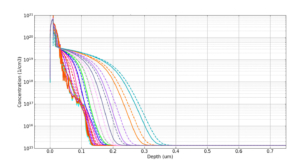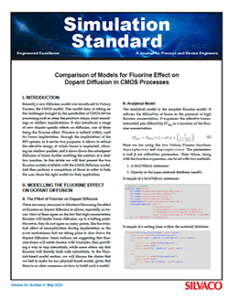Comparison of Models for Fluorine Effect on Dopant Diffusion in CMOS Processes
Introduction
 Recently a new diffusion model was introduced to Victory Process: the CMOS model. This model aims at taking on the challenges brought by the specificities of CMOS device processing such as steep temperature ramps, short annealings or shallow implantations. It also introduces a range of new dopant specific effects on diffusion, one of them being the fluorine effect. Fluorine is indeed widely used for boron implantation, through the implantation of the BF2 species, as it serves two purposes: it allows to reduce the effective energy at which boron is implanted, allowing for shallow profiles, and it slows down the subsequent diffusion of boron further enabling the creation of a shallow junction. In this article we will first present the two fluorine models available with the CMOS diffusion model, and then perform a comparison of those in order to help the user chose the right model for their application.
Recently a new diffusion model was introduced to Victory Process: the CMOS model. This model aims at taking on the challenges brought by the specificities of CMOS device processing such as steep temperature ramps, short annealings or shallow implantations. It also introduces a range of new dopant specific effects on diffusion, one of them being the fluorine effect. Fluorine is indeed widely used for boron implantation, through the implantation of the BF2 species, as it serves two purposes: it allows to reduce the effective energy at which boron is implanted, allowing for shallow profiles, and it slows down the subsequent diffusion of boron further enabling the creation of a shallow junction. In this article we will first present the two fluorine models available with the CMOS diffusion model, and then perform a comparison of those in order to help the user chose the right model for their application.



